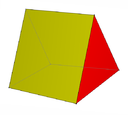- Cupola (geometry)
-
For other uses, see cupola (disambiguation).
Pentagonal cupola (example) 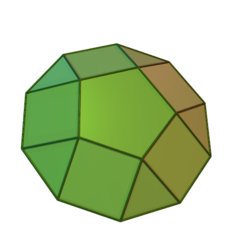
Type Set of cupolas Faces n triangles,
n squares
1 n-agon,
1 2n-agonEdges 5n Vertices 3n Symmetry group Cnv, [1,n], (*nn) Dual polyhedron ? Properties convex In geometry, a cupola is a solid formed by joining two polygons, one (the base) with twice as many edges as the other, by an alternating band of triangles and rectangles. If the triangles are equilateral and the rectangles are squares, while the base and its opposite face are regular polygons, the triangular, square, and pentagonal cupolae all count among the Johnson solids, and can be formed by taking sections of the cuboctahedron, rhombicuboctahedron, and rhombicosidodecahedron, respectively.
A cupola can be seen as a prism where one of the polygons has been collapsed in half by merging alternate vertices.
Cupolae are a subclass of the prismatoids.
Contents
Examples
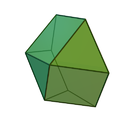 The triangular cupola with regular faces (J3)
The triangular cupola with regular faces (J3)
 The square cupola with regular faces (J4)
The square cupola with regular faces (J4)
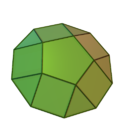 The pentagonal cupola with regular faces (J5)
The pentagonal cupola with regular faces (J5)
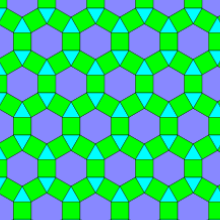 Plane "hexagonal cupolas" in one of the 8 semiregular tessellations
Plane "hexagonal cupolas" in one of the 8 semiregular tessellations
The above-mentioned three polyhedra are the only non-trivial cupolae with regular faces: The "hexagonal cupola" is a plane figure, and the triangular prism might be considered a "cupola" of degree 2 (the cupola of a line segment and a square). However, cupolae of higher-degree polygons may be constructed with irregular triangular and rectangular faces.
Coordinates of the vertices
The definition of the cupola does not require the base (or the side opposite the base, which can be called the top) to be a regular polygon, but it is convenient to consider the case where the cupola has its maximal symmetry, Cnv. In that case, the top is a regular n-gon, while the base is either a regular 2n-gon or a 2n-gon which has two different side lengths alternating and the same angles as a regular 2n-gon. It is convenient to fix the coordinate system so that the base lies in the xy-plane, with the top in a plane parallel to the xy-plane. The z-axis is the n-fold axis, and the mirror planes pass through the z-axis and bisect the sides of the base. They also either bisect the sides or the angles of the top polygon, or both. (If n is even, half of the mirror planes bisect the sides of the top polygon and half bisect the angles, while if n is odd, each mirror plane bisects one side and one angle of the top polygon.) The vertices of the base can be designated V1 through V2n, while the vertices of the top polygon can be designated V2n+1 through V3n. With these conventions, the coordinates of the vertices can be written as:
- V2j-1: (rbcos [2π(j-1)/n + α], rbsin [2π(j-1)/n + α], 0)
- V2j: (rbcos (2πj/n - α), rbsin (2πj/n - α), 0)
- V2n+j: (rtcos (πj/n), rtsin (πj/n), h)
where j=1, 2, …, n.
Since the polygons V1V2V2n+2V2n+1, etc. are rectangles, this puts a constraint on the values of rb, rt, and α. The distance V1V2 is equal to
rb{[cos (2π/n - α) – cos α]2 + [sin (2π/n - α) - sin α] 2}1/2
= rb{[cos 2 (2π/n - α) – 2cos (2π/n - α)cos α + cos2 α] + [sin 2 (2π/n - α) – 2 sin (2π/n - α)sin α + sin 2α]}1/2
= rb{2[1 – cos (2π/n - α)cos α – sin (2π/n - α)sin α]}1/2
= rb{2[1 – cos (2π/n - 2α)]}1/2,
while the distance V2n+1V2n+2 is equal to
rt{[cos (π/n) – 1]2 + sin2(π/n)}1/2
= rt{[cos2 (π/n) – 2cos (π/n) + 1] + sin2(π/n)}1/2
= rt{2[1 – cos (π/n)]}1/2.
These are to be equal, and if this common edge is denoted by s,
rb = s/{2[1 – cos (2π/n - 2α)]}1/2
rt= s/{2[1 – cos (π/n)]}1/2
These values are to be inserted into the expressions for the coordinates of the vertices given earlier.
Hypercupolas
The hypercupolas are a family of convex nonuniform polychora (here four-dimensional figures), analogous to the cupolas. Each one's bases are a Platonic solid and its expansion.
Tetrahedral cupola Cubic cupola Octahedral cupola Dodecahedral cupola Icosahedral cupola 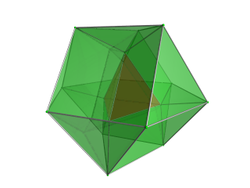
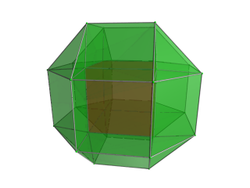
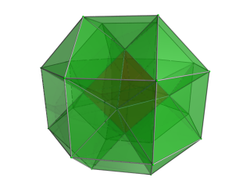
Vertices 16 32 30 80 72 Edges 42 84 84 210 210 Faces 42 24 triangles
18 squares80 32 triangles
48 squares82 40 triangles
42 squares194 80 triangles
90 squares
24 pentagons202 100 triangles
90 squares
12 pentagonsCells 16 1 tetrahedron
4 triangular prisms
6 triangular prisms
4 triangular pyramids
1 cuboctahedron28 1 cube
6 square prisms
12 triangular prisms
8 triangular pyramids
1 rhombicuboctahedron28 1 octahedron
8 triangular prisms
12 triangular prisms
6 square pyramids
1 rhombicuboctahedron64 1 dodecahedron
12 pentagonal prisms
30 triangular prisms
20 triangular pyramids
1 rhombicosidodecahedron64 1 icosahedron
20 triangular prisms
30 triangular prisms
12 pentagonal pyramids
1 rhombicosidodecahedronExternal links
- Weisstein, Eric W., "Cupola" from MathWorld.
References
- Johnson, N. W. Convex Polyhedra with Regular Faces. Canad. J. Math. 18, 169-200, 1966.
Polyhedron navigator Platonic solids (regular) Archimedean solids
(Semiregular/Uniform)Catalan solids
(Dual semiregular)triakis tetrahedron · rhombic dodecahedron · triakis octahedron · tetrakis cube · deltoidal icositetrahedron · disdyakis dodecahedron · pentagonal icositetrahedron · rhombic triacontahedron · triakis icosahedron · pentakis dodecahedron · deltoidal hexecontahedron · disdyakis triacontahedron · pentagonal hexecontahedronDihedral regular Dihedral uniform Duals of dihedral uniform Dihedral others Degenerate polyhedra are in italics.Categories:- Polyhedra
- Prismatoid polyhedra
- Johnson solids
Wikimedia Foundation. 2010.

